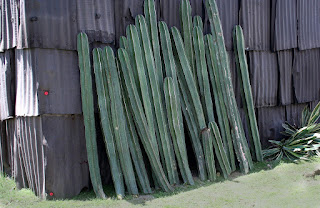Landscaping dreams



Encircled with police-type yellow tape, my gardens right now probably look more like crime scenes. The only thing missing is the chalk outline on the ground of some unknown stiff.
Actually if you look at the gardens up close they are not that bad at all. This morning Stew and I (and Lucy and Gladys, traveling mutts extraordinare) visited the place and indeed the bones of a landscape scheme clearly are starting to emerge.
The three challenges I faced, and which no amount of reading of glossy gardening books seemed to resolve, were rocks, sheer expanse and erosion. Rocks we've talked about before; particularly in the dead of winter they give the land a lunar appearance.
Size also complicated things, sometimes making any gardening vision almost impossible at least for my untrained eye. Where do you start? It's not the 25 by 25 foot backyard we had in Chicago, but seven and a half acres, surrounded by farm fields and mountains. There aren't many trees either to help define boundaries or provide perspective. Even if we could air-drop dozens of 15-foot trees, they'd become specks against such a vast backdrop.
The final problem is erosion. It carries the water and soil toward the lower third of the property, which is almost lush green compared to the top where the house sits and where I'm trying to plant some gardens.
Out of these three problems we came up with what we think is a clever yet obvious solution--terracing. It gives us something to do with the thousands of rocks everywhere, though they seem to be procreating: For every one rock we dig up, three more appear.
I hope these semi-circle terraces of rocks also will help slow down the avalanche of water and dirt rolling down the hill. After a while the terraces may trap some soil where we could grow some wildflowers.
The terraces also created relatively confined spaces with one or two anchor shrubs or cacti which make it easier to mix and match plants, their textures, sizes etc.
We've hired two young guys, Ivan and Félix, who look sometimes to be engaged in some sort of Sisyphean labor, digging up and moving rocks, covering up the holes left behind, making piles, moving the piles, and over again. Their work and sweat are obvious but visible results often elusive.
I asked Felix, about 20 years old and who lives in a nearby rockpile of a village called Sasnovar, where I could get some organ cacti. I warned him I didn't want any "hot" cacti uprooted from someone's land. No problem. He and his tiny, hunched-over mother (grandmother?) went to work on their backyard with a machete and quickly produced 25, six-foot lengths of cacti for $10 pesos or 75 U.S. cents each.
Took the organs to the ranch where I leaned them against a wall. Actually you're supposed to lay them down until the wound dries up, about a week, when they are then ready to be planted.
Buying trees from the local nurseries is frustrating unless you find a knowledgeable and honest person in charge. A local joke is that if you go into a nursery and ask whether a particular shrub takes sun or shade, the usual answer is "¡Sí!" The person you are talking with either doesn't know the cultural requirements or they will tell you whatever you want to hear to sell you the damn thing.
Aside from the 25 organ cacti, we've bought several agaves, including some variegated beauties, plus we have planted several that we had in pots in our current house. (The sale contract stipulates the buyers get all the plants except the cacti and the succulents.) We also have three cypresses, pencil-skinny and tall, rocking merrily in the constant breeze, a níspero tree (called Japanese loquat in the U.S.) and which produces a delicious fruit I used to eat in Cuba as a child (but whose flavor I can't remember). Some ornamental grasses, pennisetum and blue fescue, plus the wild card, thousands of wild flower seeds Stew and I collected last fall and scattered about a month ago. Also three bottle-brush bushes (very common along the highway medians in San Miguel) and a pata de vaca tree (it translates as "cow's foot" though I couldn't find any English name for it). The latter has floppy leaves that indeed look like the outline of a cow's foot though they are generally folded in half.
On my shopping list is an olive tree (they seem to thrive in San Miguel's poor soil) plus some citrus and fruit trees. It gets quite cold in Rancho Santa Clara, dipping as low as 30 degrees in the winter, but the really problematic factor is the constant wind which sucks the moisture out of the soil and the leaves of plants.
Difficult as it may be the next step in my landscaping blitz is to stop. Ivan and Félix will continue gathering rocks, making terraces and planting organ cacti for a few more weeks. But until the house is much closer to finished, the grounds relatively clean--and the sightlines better defined--any more tree-planting will just have to wait.

Comments
Post a Comment
Let us hear your opinions, thoughts and comments